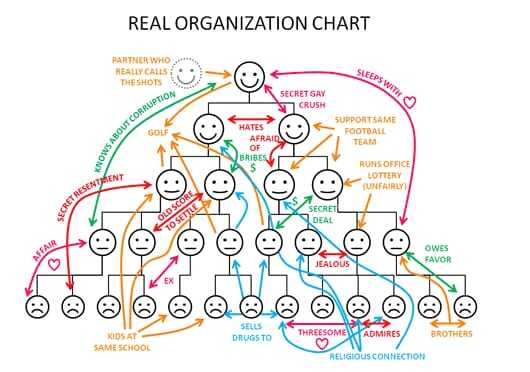Agile Manifesto | Principle 11

Principle 11
The best architectures, requirements, and designs emerge from self-organizing teams.
Agility requires the acceptance that any complex system, such as an organisation, is self-organised by nature.
In most startups we encounter a so-called network structure. In the absence of a top-down imposed organisational model and given a common purpose, humans naturally self-organise in a way that information flows freely and that they involve the relevant people in their contemplations and advance towards a solution. In an effort to make these connections more efficient as the organisation grows, given the impossibility of everybody being regularly connected with everybody, humans introduced top-down hierarchical organization models.
Scaled-Agile methodologies, such as SAFe, advocate for a “dual operating system” – keeping the traditional hierarchy in place to provide efficiency & stability, while at the same time allowing for a dynamic network of people that operate at the speed of innovation. While this dual operating system caters for the ambiguity between stability and agility, the holy grail question is: How can we conceptualise natural self-organization of humans on a scaled level in form of an organizational model? Accepting and allowing for natural self-organization to happen means that we will have to transcend previous organizational models. This entails a paradigm shift and a new logic – a new way of thinking – which is why this is such a difficult endeavour. Scaled-agile methodologies have set themselves up for the challenge and it is Gladwell’s mission to custom-design such models together with our customers.

It is the dichotomy between instability & stability where agility lies.
One aspect of self-organization is to allow for emergence, in particular emergent design and architecture that evolve along with feature delivery and changing needs and requirements. Further, an agile leader trusts their employees to have the relevant competence to know best how to get the job done (Principle 5) and therefore gives them the freedom to make those how-decisions. In addition, allowing for participation is vital; in an agile organisation all people who have something relevant to contribute on a certain matter are welcomed to do so. In fact, if an organisation lives true agility, employees feel a collective responsibility for the prosperity of the organisation, so they won’t hide behind their job description, but act and speak up when encountering problems.
Curious about science-based principles which facilitate self-organization and enable us to capitalizes on it? We recorded our 2nd Transformation Journey webinar for you to rewatch any time convenient for you: https://www.gladwellacademy.com/knowledge/webinar/theory-practice-in-enabling-agile-self-organization
Explore each principle & value with us
Introduction to the Agile Manifesto & Part 1 – The Agile Team: Skills & Culture
Principle 1: Our highest priority is to satisfy the customer through early and continuous delivery of valuable solutions*.
Principle 2: Welcome changing requirements, even late in development. Agile processes harness change for the customer's competitive advantage.
Principle 3: Deliver working solution* frequently, from a couple of weeks to a couple of months, with a preference to the shorter timescale.
Principle 4: Business people and team* must work together daily throughout the project.
Principle 5: Build projects around motivated individuals. Give them the environment and support they need, and trust them to get the job done.
Principle 6: The most efficient and effective method of conveying information to and within an agile team is real-time conversation.
Principle 7: Working solution* is the primary measure of progress.
Principle 8: Agile processes promote sustainable development. The sponsors, team*, and users should be able to maintain a constant pace indefinitely.
Principle 9: Continuous attention to technical excellence and good design enhances agility.
Principle 10: Simplicity – the art of maximizing the amount of work not done – is essential.
Principle 11: The best architectures, requirements, and designs emerge from self-organizing teams.
Principle 12: At regular intervals, the team reflects on how to become more effective, then tunes and adjusts its behavior accordingly.
Value 1: We value individuals and interactions over processes and tools.
Value 2: We value working solution* over comprehensive documentation.
Value 3: We value customer collaboration over contract negotiation.
Value 4: We value responding to change over following a plan.
*LEGEND:
Business Value: Business Value encompasses any deliverable, feature, or enhancement that directly contributes to customer satisfaction, employee well-being, or overall organizational success. It can encompass not only customer-facing elements but also internal enablers that improve efficiency and effectiveness within the organization.
Developers: has been exchanged by team to recognize that Agile Teams can encompass a diverse range of roles and functions beyond just software development
Iteration: An Iteration refers to a distinct phase or cycle within a development process, where a set of tasks or activities are completed in a defined timeframe. In Scrum methodology, an Iteration is known as a Sprint, typically lasting 2-4 weeks, during which a set of prioritized work items are completed.
Lead Time: Lead Time refers to the duration it takes for a task or project to move from the initial request or conception stage to its completion, including all necessary processes and steps.
MVP (Minimum Viable Product): The MVP is a basic, functional version of a product or service that includes essential features, allowing it to be deployed or released to gather early feedback from users or customers.
Software: has been replaced by solutions to account for the fact that Agility does not only apply to software development, but to any kind of value that a business offers to the customer.
It might also interest you!

Agile Manifesto | Principle 12

Agile Manifesto | Value 1
